
22 minute read
Soapbox
Boebert and deep state satanists
To the editor,
Advertisement
Just how much demented tripe are we being asked to normalize? Most sources agree that QAnon is a conspiracy theory that teaches Donald Trump is battling “deep state” satanists, comprised of Hollywood figures, the media and, of course, Democrats. These alleged actors are said to be cannibals and pedophiles who, among other things, engage in sex-trafficking of children whose blood they drink.
Trump has said those who subscribe to such nonsense “love our country” (White House press conference, Aug. 19). On the other hand, the FBI has called QAnon a “potential domestic terrorism threat” (New York Times, Aug. 15). And Lauren Boebert, CD3 Republican candidate, was quoted in a July 1 article in The Guardian as saying she is “very familiar” with the QAnon conspiracy theory.
Indeed, Boebert pontificated in a June interview with “Steel Truth,” a podcast that supports QAnon, as follows: “Everything I’ve heard of Q – I hope this is real, because it only means America is getting stronger and better, and people are returning to conservative values, and that’s what I am for. And so everything that I have heard of this movement is only motivating and encouraging and bringing people together stronger, and if this is real, then it could be really great for our country,” (CBS News, July 1)
While Boebert’s campaign spokeswoman Laura Carno understandably is anxious to close the book on her boss’ flirtation with QAnon, Boebert keeps opening it up again. On Aug. 17, Boebert tweeted that Tom Hanks was “a newly minted Greek citizen” in support of the QAnon social media theory that claims Hanks became a citizen of Greece because “it classifies pedophilia as a disability,” (Colorado Times Recorder, Aug. 19.) Ha ha.
Boebert may now want to distance herself from this fringe-iest of right wing fringe groups that is QAnon. However her initial embrace of Q does not speak well of her judgment or character. The CD3 deserves a serious person as its representative. The CD3 deserves an experi
enced, reasonable, competent public servant. That person is Diane Mitsch Bush. – Joyce Jenkins, Glenwood Springs 4
Daily Deal:
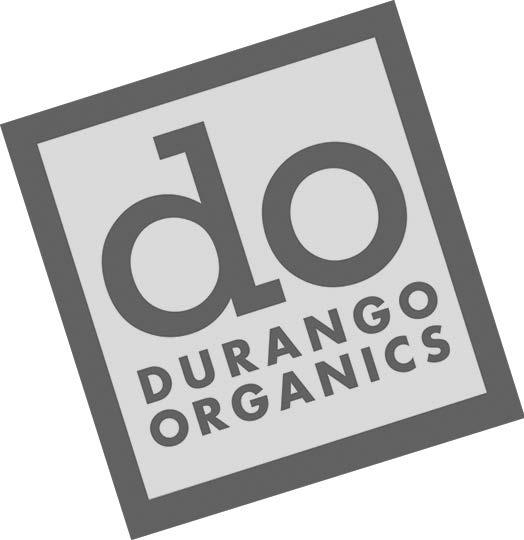

25% Off all The Clear products Every day, 3-7 p.m.

The Alternative Resource Variety of Strains • Hash/Concentrates • Edibles • Tinctures • ATM

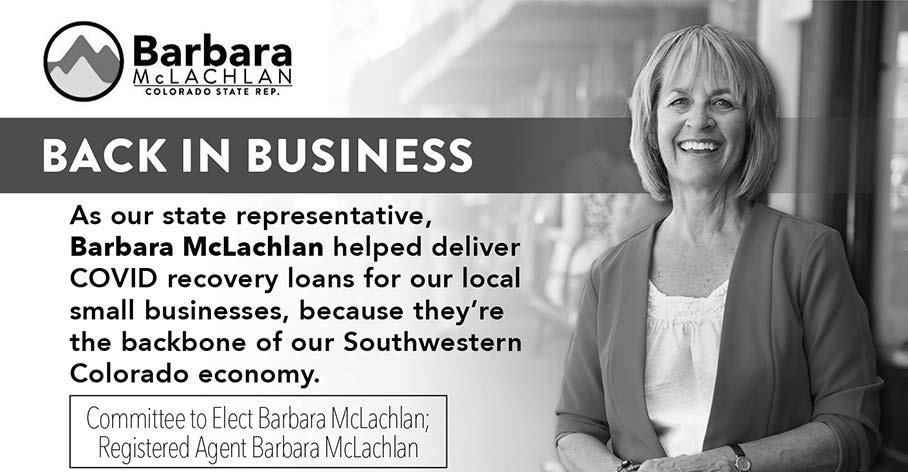
Bodo Park Recreational: 9:00 AM - 9:00 PM Medical: 9:00 AM - 6:45 PM 72 Suttle Street, Units F/G , 970.259.3674
Grandview (HWY 160 East) Recreational Adult Use Only: 9:00 AM - 8:00 PM 37 CR 232, 970.426.4381
Vote yes on 114 – wolves belong
To the editor,
Wolves belong in Colorado. They belong for ethical and moral reasons because citizens want them back, and for their essential role in maintaining ecosystem health and integrity.
I was CDOW’s biological staff lead for the development of Colorado’s current wolf management plan in 2004-05, and along with work since retirement, so I have a pretty strong knowledge base when it comes to wolves.
Wolves and their prey coexisted in Colorado for tens of thousands of years before we eradicated them a mere 80 years ago. That was an action that most folks supported at the time, but in hindsight we can see it was a mistake.
Wolves strongly and positively affect ecosystems wherever they live. The restoration of wolves to Yellowstone National Park is informative. While there’s no question that Colorado isn’t Yellowstone, we can learn a lot from what happened there and throughout the northern Rockies when wolves were restored. Ecologists know that all parts of ecosystems function together in ways that we don’t understand and probably never will. Wolves helped improve ecological conditions throughout the northern Rockies, and they will do the same in Colorado.
Exterminating wolves in the last century removed an influential player in those dynamic ecological processes, and we know that we can restore them. Restoration can be done humanely and in ways that respect all Coloradans, and it’s easy: all it takes is something to eat and human tolerance. Colorado has plenty of prey for wolves, with 280,000 elk and 420,000 deer, many of them on the 16 million acres of public land (over 70 percent of the area) on the Western Slope. People can live with wolves, as folks in the upper Midwest, the northern Rockies, and across Europe and Asia have done. Many of those places have higher densities of both wolves and humans compared to what we would expect in Colorado.
Addressing some myths: • Wolves won’t wipe out elk: Elk populations in Montana, Wyoming and Idaho are higher than they were when wolves were restored in 1995. There have been some changes in distribution and behavior, but there are more elk overall. • Humans are safe; in the last 90 years, there are only two confirmed human deaths caused by wolves in North America. For comparison, at least 40 people are killed by lightning every year in the United States, or 3,600 people in the last 90 years. • Livestock won’t be wiped out. Wolves will kill some livestock, but wolves will not cause the livestock industry to fail. In Montana, Idaho and Wyoming, in 2015, there were more than 1.6 million cattle in counties that had wolves, and 148 of them were killed by wolves, or 0.01 percent. That’s one out of 10,000 cattle. Sheep are more vulnerable, but still depredation is at 0.03 percent or 1 out of 3,333. • The misinformation about hydatid disease is total fearmongering. This disease is indeed carried by wolves, and by foxes, coyotes and domestic dogs, the latter being the most common source of infection in humans. The attempt to brand it as “Gray Wolf Disease” is misguided; if you want to name it after the host it would be better called “Border Collie Disease.” The reason you probably never heard of it before is that it’s not an important health issue. None (as in zero) of the thousands of biologists who have worked on wolves have ever contracted the disease. Best advice: don’t eat poop from dogs, coyotes, foxes or wolves.
One of the best reasons to restore wolves to Colorado is that voters want to see them returned to the state. A September 2019 CSU poll found that 84 percent of voters intend to approve wolf restoration, including 79.8 percent of those on the Western Slope, 69.5 percent of ranchers and 62.1 percent of hunters.
Anyone wanting to dive deeper into wolf issues should search “Colorado State CHCC” and spend some time exploring the excellent FAQs and fact sheets in the “People and Predator Series” that the scientists at Colorado State have created regarding restoring wolves to Colorado. You’ll be a better-informed voter for having done so.
Proposition 114 allows voters to set public policy. When the measure passes, the people will have made their desires clear, and wildlife professionals in Colorado will then use their well-respected expertise and knowledge to implement that direction and restore a native species.
Isn’t that how it’s supposed to work? – Gary T. Skiba, Aztec
An agent of positive change
To the editor,
It’s Marsha time! I’m thrilled to vote for Marsha PorterNorton for County Commissioner because she is exactly the judicious, intelligent, pro-community person we need in these times of uncertainty (it’s not as if we can continue to throw money at problems these days). Please join me in electing this salt-of-the-earth person who has dedicated her professional life to working alongside people buried in conflict so that everyone may reach great and timely solutions.
As an elected official, I experienced first-hand the ways she deftly facilitated important intergovernmental conversations. Beyond that, she is an agent of positive change and a source of empowerment in our community. Need roads and bridges? Personal health resources? Predictable development? Renewed economy? Vote Marsha. – Leigh Meigs, former mayor and Durango city councilor
Don’t ground the slackliner
To the editor,
Amidst writing countless postcards to get out the vote, the suffering of the pandemic and the increasing visibility of systemic racism in this country, I’ve come to know spontaneous, enormous joy when I go on my morning run/walk and see one of our own literally walking through the sky at Horse Gulch. Joy is revolutionary! We need the presence of joy to do what needs to be done for our beautiful and troubled world.
These unexpected moments of delight have been treasures to me – witnessing human confidence, embodiment and love as I take a hike. When I walk from my home on the southside near Horse Gulch, I’ve stopped on my morning trek three times now to notice this man gracing us with his fluid beauty as a sky-walker. Today, I both paused and applauded from the trail below, and learned that a cease-and-desist order had been placed so he would not be venturing into the sky of Horse Gulch anymore. It was fun to shout out to him up on the ridge, as he had just completed his slackline. I’m curious to understand why a cease and desist would be necessary. I celebrate this bright spirit, in all the moments when we might be courageous and surprise each other in ways that nourish our hearts and our lives.
Let’s carry on! – In kindness, Erin Treat, Durango
Paging Lauren Boebert
To the editor,
Please participate in a Zoom forum Oct. 8 featuring candidates running for the U.S. House of Representatives for Colorado’s 3rd District, hosted by the League of Women Voters of La Plata County. The LWV is nonpartisan and dedicated to educating the public so they can be informed voters.
The LWV invited both candidates to participate in the forum. Only Diane Mitsch Bush accepted the invitation; Lauren Boebert declined.
Having reviewed both candidates’ websites to get a better understating of their positions, I was hoping that the forum would provide more details about their specific plans to address the following issues: • The pandemic has been more devastating and fatal to us because our government has gutted our social safety nets. We lack accurate tests that give us results in a timely manner; we have lost over 1,000 health-care workers, primarily from a lack of PPE. If elected, how would you begin to rectify those problems? • How would you balance environmental protections and minimize our recurring wildfire crisis? • The pandemic is worsening our housing situation, which is on the verge of a crisis. How would you create new jobs reducing financial hardships in our district? • How would you make changes and improvements to our badly broken health-care system that serves adequately only those with high incomes?
I am disappointed that Ms. Boebert declined to participate. However, I would welcome responses to the above questions from both candidates. – Jan Phillips, Durango
The ballots are coming!
The La Plata County Clerk and Recorder’s Office will being mailing ballots to registered voters Fri., Oct. 9. In preparation, the Telegraph has a slew of useful election info coming your way:
• Oct. 8: La Plata County commissioner ques
tionnaire. With sitting commissioners Julie Westendorff (District 3) and Gwen Lachelt (Distrct 2) term limited, there are two seats open on the three-person board. This is an at-large contest, meaning voters may select one candidate from each district race. Tune in while District 2 candidates Jack Turner(I) and Marsha PoterNorton(D) and District 2 candidates Charlie Minkler(I) and Matt Salka (D) weigh in on all the pressing issues and burning questions.
• Oct. 15: Ballot Cheat Sheet.
There are no fewer than 11 statewide referendums on this year’s ballot, as well as the local 9-R school bond issue. The Telegraph will try to make heads or tails out of this year’s massive Blue Book in an easy-to-digest, nonsnoozy format. *Please note, depending on available space, writer’s fatigue and carpal tunnel, this may be spread out over two weeks.
And, most importantly, if you haven’t registered to vote, get on it. Colorado offers online voter registration (www.sos.state.co.us) through Oct. 26 or you can register by mail by printing a voter registration form, filling it out and mailing it to your local election office (also by Oct. 26). You can even register to vote in person as late as Election Day, which of course is Nov. 3


Freshly picked apples fill a bowl on their journey to becoming pie. Southwest Colorado once again is experiencing a bumper crop of apples, and the Good Food Collective is helping to make sure all that goodness doesn’t go to waste. In addition to weekly gleaning happy hours, it’s selling fresh cider in conjunction with Apple Days, on Oct. 10, and helping local residents
and orchards deal with the abundance./ File photo

’Dem apples
Bumper crop has pickers, growers and gleaners busy by the bushel load
by Missy Votel
Up to your eyeballs in apples? Or peaches, pears, zucchinis or quinces? The Good Food Collective is here to help. Not only does the local nonprofit offer fruit pickers for hire, it hosts a weekly fruit-gleaning club, where the volunteer fruit-picking angels come and relieve you of all your excess fruit. And, if you’re more of a do-it-yourselfer, fruit-picking kits and even a portable apple press are available for rent.
“It’s been a bumper crop for fruit for sure,” the Collective’s Executive Director Rachel Landis said Tuesday. “Things are going crazy.”
Just how crazy? This harvest season, the GFC expects to help harvest close to 185,000 pounds of fruit and veggies –that’s more than 92 tons. By comparison, it harvested a relatively measly 118,000 pounds in 2019.
But just what to do with all that food? (For the purposes of this story we’ll stick to apples, just so we’re comparing apples to, well … you know.)
For starters, the bad apples – which aren’t “bad” in a villainous way, just blemished or unfit for human consumption – will be fed to the piggies. The GFC works with local farmers who put the produce to use on their feedlots. Some of the “good” apples will go to local cideries for the hard stuff, and some will be pressed into cider (the light stuff) for the upcoming Apple Days Festival, Oct. 10, at the Farm

A picker with the Good Food Collective gathers apples recently. In addition to sending some apples to local food pantries, some apples will be pressed into cider for the upcoming Apple Days Festival. It takes 18 pounds of apples to make one gallon of cider./
Courtesy photo ers Market. (A small factoid: it takes 18 pounds of fresh apples to make one gallon of cider.)
As for the rest, it will be given to local food banks and pantries.
“With the pandemic, we went from one in eight people being food insecure to one in three,” said Landis. “There has been a tenfold increase in demand at food banks.”
And that food insecurity is what is at the heart of the GFC, which started in 2018 as a way to shore up the regional food system and make sure good food doesn’t go to waste.
“We’re just trying to get as much fresh, healthy food to people who need it this season,” said Landis.
Part of that equation is a new industrial food dehydrator that is expected to arrive next week from Eugene, Ore. The dehydrator will be housed at Durango Artisan Foods and available for public rental as well as serving the GFC’s needs. She said the dehydrator will help extend the life of apples and other fruit on pantry shelves, which otherwise would go bad.
“There are a lot of programs that are limited to shelf-stable goods only,” she said.
The program will be called “Fruit for Good,” and Landis said there’s a chance the dried produce could eventually land on local store shelves. Proceeds from the fruit sales would be used to finance the GFC and its program. Landis said the income will help offset the organization’s depend
ence on grants, which are not always a sure thing. “There’s no telling if grants will be available year to year,” she said.
And speaking of income, another tenet of the GFC is to pay farmers and growers for their food – the literal fruits of their labor –when at all possible. This helps keep farmers in business and the local food supply chain going. The GFC is also working to help pantries buy produce directly from the farmers.
“The goal is to get food assistance programs to buy as much produce as possible from local growers,” she said. “We’re helping them with things like, how do you buy from a farmer? It’s different from ordering off a Sysco truck.”
The GFC is also helping to advocate for local food at a state level and tap into the $1 million that is available for local food procurement. Closer to home, it helped land $100,000 in CARES Act funding from La Plata County to go to local food assistance, with a portion of the money to be used to buy food directly from local farmers. Landis said the funds will be a welcome boost to local farmers who saw part of their revenue dry up during the pandemic when restaurants and schools closed.
Although the GFC has taken over the annual Apple Days festival and local gleaning activities, Landis is quick to note these things were all in place long before her organization came along. Rather, the GFC is just part of a bigger movement of pivoting toward local food across the Four Corners and the country.
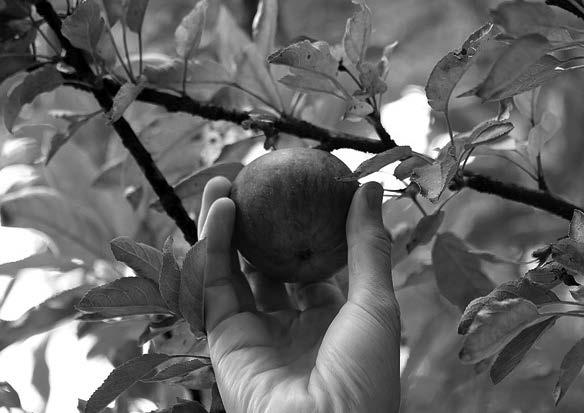
“It’s not just us, there’s a sea change going on,” she said. “We’re just here to help fill in gaps so we have a regional food system that’s healthy and can feed people.”
And speaking of Apple Days, this year will be the 12th annual, albeit in a smaller COVID-era format. “It’s very much Apple Days light,” she said.
Instead of the usual brouhaha at Buckley Park, this year’s Apple Days will take place at the Farmers Market on Oct. 10. There will be an apple press demo, but it won’t be allhands-on-deck as in years past. Instead, folks can pre-order their cider on the GFC’s website (goodfoodcollective.org) and pick it up that day.
Local gleaners and pickers have been busy making sure this season’s bounty doesn’t rot on the ground. The Good Food Collective expects to harvest about 185,000 pounds of apples this season, for use in ciders, dried fruit and even pig feed.
And to get ready for the orders, the GFC is seeking volunteers to help harvest apples next week (sign up also at goodfoodcollective.org.)
Landis is hopeful to draw upon people hungry for social (-ly distant) engagement and some positive news for a change.
“We can’t do a massive fest, but at least we’ll get people out there and give them something real and hopeful,” she said. “It may sound silly, but it’s such a simple joy to go out and pick an apple.”
To rent a harvest kit, sign up for next week’s apple harvest or volunteer at a Wednesday fruitgleaning happy hour, go to www.goodfoodcollec tive.org. n
The hard stuff: Now not one but two options
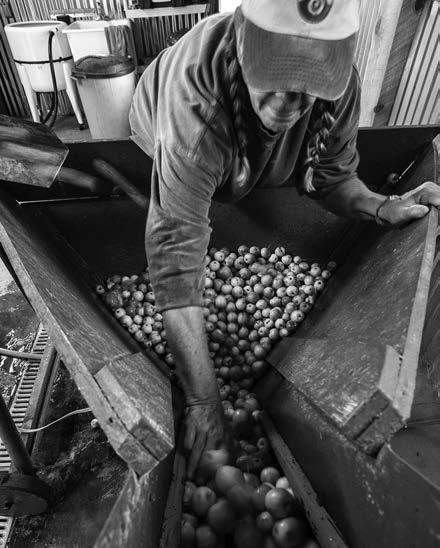
Like your cider with a little kick? per year to a friend or family There are now not one, but two opmember. Order deadline for the first tions for locally made hard cider. shipment is Oct. 1 (today!) but new
Launched in early 2018, Fenceline members will be accepted throughout Cider (also known as Outlier Cellars) the year on a rolling basis. For more inwas the OG cider maker, setting up formation visit: www.fenceline.co/club base in Mancos along the idyllic banks There is also a new kid on the hard of the Mancos River. cider block, EsoTerra Ciderworks, which
Started by Sam Perry and Neal opened last week in Dolores and is Wight, Fenceline uses apples from the owned by husband and wife, Elizabeth region’s storied historic apple orchards Philbrick and Jared Scott. Also capitalizfor its line of hard ciders, which are ing on the embarrassing abundance of available in its taproom or at local heritage and rare apple varieties found liquor stores. For those who don’t like in Montezuma and La Plata counties, to venture out in these pandemic EsoTerra opened in the old Mountain times, Fenceline just introduced its Sun juice factory just east of downtown. new “Cider Club.” Available for shipIn addition to a tap room, EsoTerra ping nationwide or pick up, Cider Club also offers a custom crush facility – a limembers receive three curated bottles censed and bonded winery (technically, of Fenceline ciders every four months, cider is “apple wine”) that lets other based around the seasons. The first brands make their product in the buildshipment debuted for the fall equinox, ing. coinciding with the harvest season. “This saves them the hassle and cost Each quarterly release will also include of establishing a liquor license and the tasting notes and seasonal field obserexpense of outfitting a building, and vations from Perry and Wight. “Since opening the doors to our taproom in Mancos, we have always been inspired by creating a commuFresh apples pour down the chute en route to the press at Mancos’ Outlier Cellars, which makes Fenceline Cider./ File photo gives them the benefit of starting small,” Philbrick said in a news release. Although they got their cider-making start in Fort Collins, the couple nity around the love of craft cider,” moved to Durango a few years ago and Perry said. “Our Cider Club is a portal to share our cider across launched EsoTerra with the help of the Southwest Colorado Acthe country.” celerator Program for Entrepreneurs (SCAPE). They eventually
Memberships cost $59 (plus shipping) every three months and opened up shop along the banks of the Dolores River. include discounts on online and taproom to-go sales, VIP invitaFor more on EsoTerra, go to esoterracider.com. tions to future events and the option to gift one cider shipment – Missy Votel


The raw and the cooked
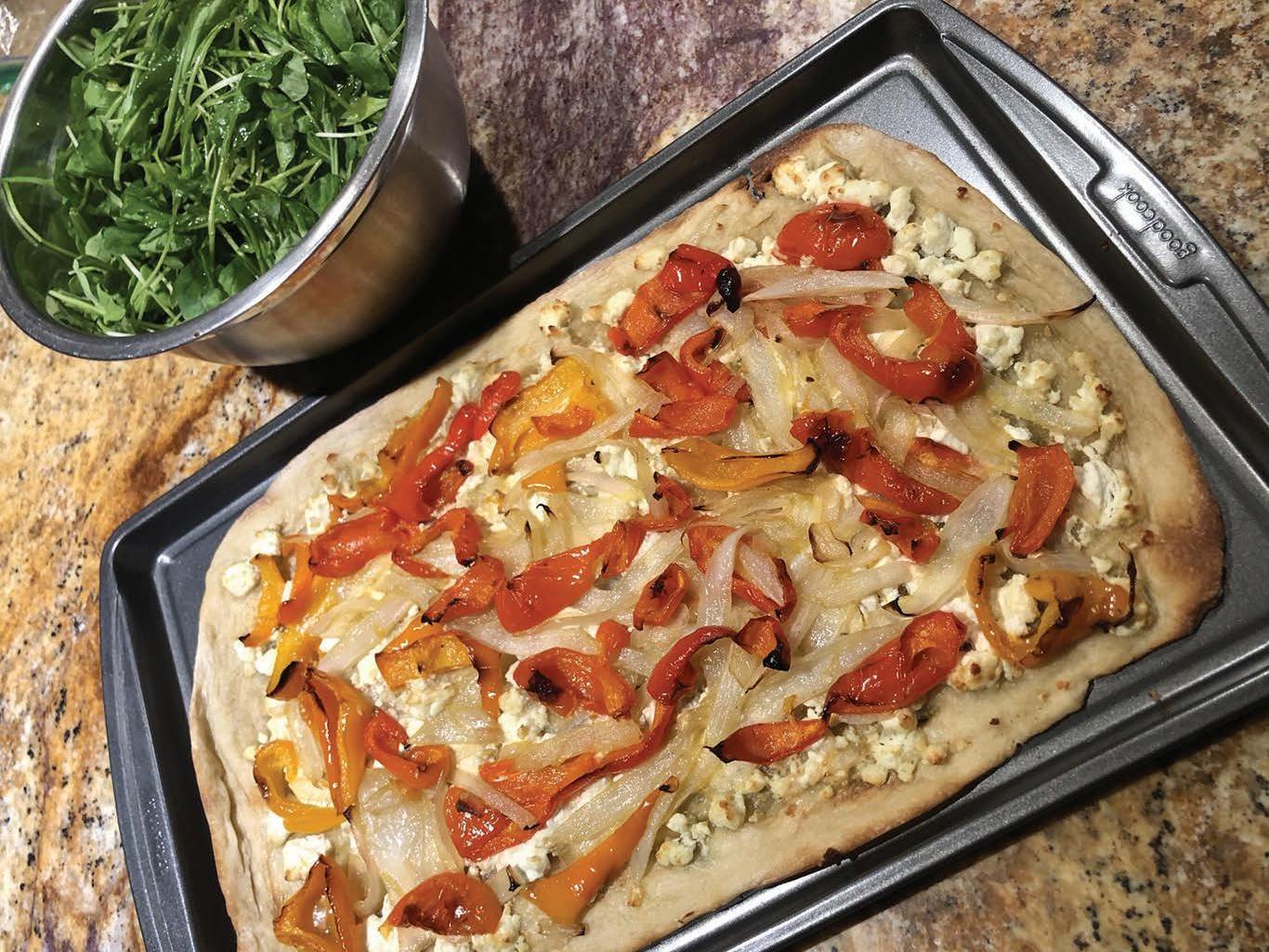
by Ari LeVaux
Most dishes are either raw, like salad, or cooked like a cake, but you can find dishes that contain both if you look. Soon, you may discover that this hybrid category contains some of your favorite foods.
The gestalt of a fish taco depends on the co-munching of cooked fish and tortilla with raw cilantro, cabbage and onions, along with sauces and cheese. Like a good piece of jazz, all of the diverse ingredients in a fish taco all do their own things together, harmoniously.
Or consider the soothing complexity of a bowl of pho, in which the eater drops bean sprouts, herbs and jalapeño slices into the hot soup. The salad adds vibrancy and fiber to the broth, yet isn’t in there long enough to get soggy, and the meal transcends semantic distinctions like “soup” and “salad.”
Pesto on noodles. Lettuce, tomato and onion on a burger or BLT. These hybrid dishes are there if you look. But I was just minding my own business when I discovered pizza with arugula salad.
It was at one of the last parties of the before times, when nobody was wearing masks and everyone grabbed pizza from the same platter without washing their hands before, during and after dinner.
‘Twas a simple pizza. A rectangle, with sliced onions and sweet peppers atop a layer of crumbled chevre, which had, deliciously, been mixed with lemon zest.
Our instructions were to pile the pizza with arugula that had been tossed in lemon juice and olive oil, and then fold the pizza around it.
Arugula is sweet and tender but spicy, and a little can go a long way. Once, I bought a bag of salad mix at a farmers market that was half arugula, and felt cheated because it was too spicy. I don’t want to eat a bowl of arugula, or its cousin the mustard greens, any more than I want to spoon a bowl of Dijon mustard into my mouth.
The brilliance of this pizza is how it uses arugula as a mustard-like condiment, adding spice and crunch as it delivers the perky lemon vinaigrette. When eaten together, pizza and greens form a delicious continuum, bright and crisp like an autumn sunset.
Sweet peppers, spicy greens. Raw salad, cooked pizza. This dish is a study in extremes. It’s also extremely delicious.
Arugula Salad Pizza
Serves 4 1 pound store-bought pizza dough 1 10-oz chevre log ¼ cup shredded Parmesan
Juice and 1 teaspoon zest from one lemon 3 sweet peppers, cleaned and sliced ½ large onion, sliced ½ cup olive oil ½ pound arugula
Let the chevre and pizza dough come to room temperature. Mix the chevre with the lemon zest and parmesan cheese in a bowl, and leave on the counter, covered.
Turn the oven to 400, and while it’s heating cut the peppers and onions. Toss them in two tablespoons of olive oil and spread them out on a cookie sheet. Roast them until the pepper skins begin to blister, stirring once or twice – about 20 minutes. When done, remove and allow to cool. Meanwhile, work on the crust.
Sprinkle some flour on your pizza pan – I use a 15 x 10 cookie sheet; a large castiron pan works too – and roll the dough around it so it isn’t sticky. Then work it into a roughly pan-sized piece. I rub it with a little olive oil to loosen it up. Make sure the pan is well oiled and slap, push, prod, squeeze and plead the dough into place.
Sprinkle the cheese mixture atop the pizza dough as evenly as you can. Then add the pepper and onion mix, as evenly as you can. Cook the pizza until the crust is brown around the edges – about 40 minutes. Use a spatula to check the bottom if you’re in doubt.
While the pizza cools, toss the arugula in the lemon juice, and roughly twice that amount of oil.
To serve, top a slice of pizza with a large dollop of arugula and squeeze the pizza around the salad to keep it in place. Eat the pizza and salad combo. Enjoy the surprising combination of spicy arugula, rich cheese and sweet peppers and onions. n




